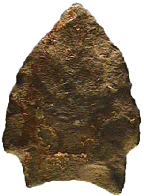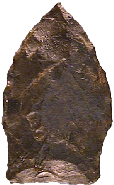



Point Type: STEUBENVILLE
STEMMED a.k.a. Fox
Creek Stemmed
Also See: Brewerton Eared
Triangle, Holland, Johnson, Savannah River, Scottsbluff , Transitional Point, Yadkin Eared
Location: Midwestern and Eastern United States
Associated Dates:
9000 - 6000 B.P. - Early Archaic
Morphology: Lanceolate
General Description: The Steubenville Stemmed is a medium to large sized, broad, triangular bladed point with straight to excurvate blade edges, weak tapered shoulders, a wide, fairly parallel sided stem and a slightly concave basal edge. The basal area is ground and the base is often thinned with the removal of thinning flakes.
There are two forms of the Steubenville point. One form has weak shoulders and a stem and is called the Steubenville Stemmed point. The second type has had the shoulders removed in the rework or resharpening process and is known as the Steubenville Lanceolate point. The Steubenville may have been used primarily as a knife due to the amount of resharpening on some specimens.
It is believed that the Steubenville Stemmed point is a descendent of the earlier Scottsbluff type. This has been a very problematic type as the age and cultural aspects are in dispute. In New York, at the Pelham Boulder Site, William A. Ritchie reported that Julius Lopez found some point that resembled the Steubenville Stemmed that were in close association with Vinette I potsherds. This indicated an early Woodland affiliation between 4000 and 3000 BP. These points, later named Fox Creek, (1955, Robert E. Funk) may be a more recent type unto itself and the Steubenvilles (both stemmed and lanceolate forms) are most likely an earlier Archaic type. Converse calls this point type the Transitional Point.
The type ranges from the Upper Ohio Valley and especially West Virginia, Maryland, Pennsylvania, the Delaware Valley area, New York, New Jersey, Connecticut, Rhode Island, and southern Massachusetts. The points were in most cases made from local materials.
The size of Steubenville Stemmed point can range from 44 mm to 88 mm in length. Thickness ranges between 6 mm and 11 mm. The Steubenville Stemmed point was named by William J. Mayer-Oakes in 1955 for the Steubenville Shell Heap site in Brooks County, West Virginia. In 1955, William A. Ritchie and Robert E. Funk decided to call the New York variety the Fox Creek point.
About the Point Above (Left): The small Steubenville Stemmed point at the top left of this page, was found near Darlington, Harford County, Maryland. This well worn point is made from a very heavily patinated black rhyolite which is encrusted with a large quantity of mineral surface deposits. The edges of the stem and base are ground and smoothed. Overall, the point measures 46 mm in length, is 32 mm wide and is 8.5 mm thick in mid blade. The concavity of the base is 3 mm deep and the base is thinned to 4 mm thick and 23 mm wide. Catalog Number 127-31-L
About the Point Above (Right): The small Steubenville Stemmed point at the top right of this page, was also found near Darlington, Harford County, Maryland. This point is made from a very heavily patinated black rhyolite. The point has a distinct mocronate tip which is rare for the type. The edges of the stem and base are ground and smoothed. Overall, the point measures 48 mm in length, is 28 mm wide and is 9 mm thick in mid blade. The concavity of the base is 1 mm deep and the base is thinned to 3 mm thick and 24 mm wide. Catalog Number 128-26-L
References: Converse, Dragoo (b,f), Fogelman, Hranicky, Overstreet, Perino (1), Ritchie
© Copyright 1997 - 2008 LITHICS-Net WWW.LITHICSNET.COM
Use Your Browser's BACK Button to Return to the LITHICS-Net Index.